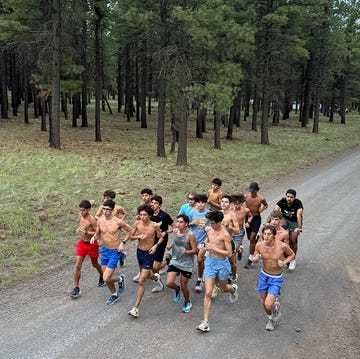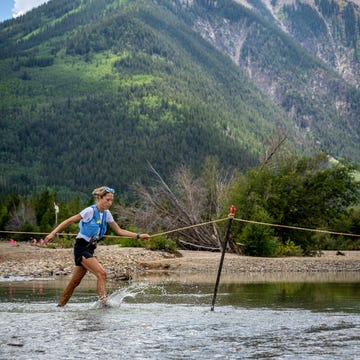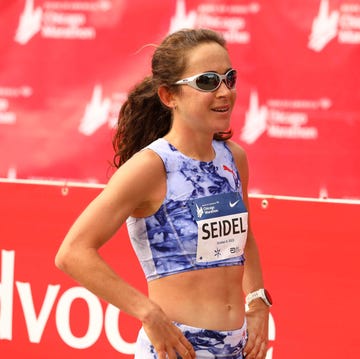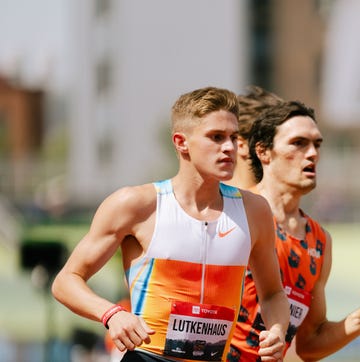Long before Usain Bolt, long before Jesse Owens, even long before Leonidas of Rhodes, we ran. More than 3 million years ago, the early hominins from which humanity emerged bipedally propelled themselves forward, perhaps in pursuit of food, perhaps evading a predator, or perhaps as a form of playful competition with their fellow Australopithecus afarensis.
We don’t know why they ran, but thanks to new analysis of Lucy, the name for the collection of 3.2-million-year-old australopithecine bones first found in Ethiopia in 1974, we now know how they ran. And how they ran is…poorly, if the write-up in The New York Times is any indication.
Now, to be clear, the Gray Lady hasn’t simply taken up the habit of critiquing the athletic form of primeval creatures like some sort of prehistoric roast. They’re reporting on new research published in the journal Current Biology, wherein physics simulations were conducted, based on a reconstructed Lucy, to determine the form and speed at which Australopithecus afarensis likely ran. And as The Times summarizes, “…she would not have been much of a marathoner and might have struggled to keep up with a contemporary couch potato in a 100-yard dash.”
Harsh, but it echoes the sentiments of Dr. Karl Bates, the lead author of the paper and an evolutionary biomechanics researcher at the University of Liverpool. “She was not a natural runner,” Bates says of Lucy. “In all probability, she could run only through short bursts of energy rather than long-distance chases.”
Though Lucy was first discovered more than 50 years ago, it’s only recently that we’ve begun to analyze and understand more about this ancient ancestor of humanity.
It was in 2016 that an autopsy on the remains was able to determine that the creature we call Lucy likely died falling from a tree.
“Seven years later,” summarizes The Times, “…a virtual reconstruction of her leg and pelvic muscles—which are not preserved in fossils—revealed that she stood about three and a half feet tall, weighed between 29 and 93 pounds, and was capable of standing and walking upright, similar to modern humans.”
And now we know that Lucy couldn’t just stand and walk—she could run.
How did the team accomplish this? They created a computer simulation which used “the surface area of her bones and the muscular architecture of modern apes to estimate her muscle mass.” From there, as can be seen in a video on The New York Times website, the simulation cycles through “millions and millions of different sequences” according to Dr. Bates, until it finds one that offers “the fastest speed with minimum energy cost.”
Bates and his team then created a model based on a current day human, which The Times notes, had “measurements [which] echoed those of the 5-foot-9, 154-pound Dr. Bates, who is 38.” For his part, Bates states that the reason for the comparison between cyber-Lucy and cyber-Bates is that it “allowed us to give a sort of maximum and minimum speed estimate for Lucy,” and it allowed the team to “compare the effects that important anatomical features in human evolution had on running speed.”
And that’s all absolutely true. But it does feel a little mean to poor Lucy to not only show that she was slower than a generic modern human, but to specifically be able to say “I, Dr. Karl Bates, personally would have absolutely demolished this hominin in a 5K, dude.”
The New York Times notes that Lucy’s top running speed in the simulation was “a relatively modest 11 mph.” Which, sure, isn’t quite up to what modern humans can do, since they note that contemporary sprint speeds in humans can exceed 18 mph and even peak at higher than 27 mph in top athletes.
But the hits keep coming for our favorite hominin: “Dr. Bates speculated that in a 100-meter race, Usain Bolt, the world-record holder at that distance, would have beaten Lucy by somewhere between 50 and 80 meters.”
So sure, Lucy couldn’t beat Usain Bolt in a race (who among us could?), but it’s not her fault: she wasn’t built for it.
“On the whole, the hominins were living in places that had lots of trees, bushes, and shrubs,” paleontologist Denise Su told The Times. “Prey species in more closed habitats tend to hide and freeze as a response because there is a lot more cover, and you can’t run fast on landscapes with a lot of cover.”
They were even able to determine what specific physical feature was Lucy’s undoing as a runner. Her Achilles heel, as it were, was a lack of an Achilles tendon. “Lacking the long, elastic Achilles tendons and shorter muscle fibers present in the legs of contemporary humans,” they note, “Lucy would have had to work harder to move quickly.”
They even tested this out in their simulation:
“When humanlike ankle muscles were added to the cyber Lucy, the amount of energy that she expended was comparable to that of other animals of similar stature. But tack on apelike ankle muscles, and she would have spent three times as much energy running as a modern human.”
So, now we know, Lucy’s lack of Achilles tendon caused her to be as slow as a pig. It might also explain why she was the tree from which she fell and died, because she had to resort to hiding instead of being able to flee predators on foot. And, most of all, we know that 38-year-old evolutionary biomechanics researcher Dr. Karl Bates would absolutely wreck an Australopithecus afarensis in a 100-meter race, no question.
Now typically, here at Runner’s World, we would express the sentiment that it’s never too late to improve your running pace, whether through helpful tips or even just a change in mindset. But we’re calling it here, right now, it is in fact too late for Lucy the 3.2 million-year-old hominin to improve her pace, because she is, in fact, very, very dead. But for the rest of us, let’s all be a little more thankful for our Achilles tendons when we hit the track.
Michale Natale is a News Editor for the Hearst Enthusiast Group. As a writer and researcher, he has produced written and audio-visual content for more than fifteen years, spanning historical periods from the dawn of early man to the Golden Age of Hollywood. His stories for the Enthusiast Group have involved coordinating with organizations like the National Parks Service and the Secret Service, and travelling to notable historical sites and archaeological digs, from excavations of America’ earliest colonies to the former homes of Edgar Allan Poe.















